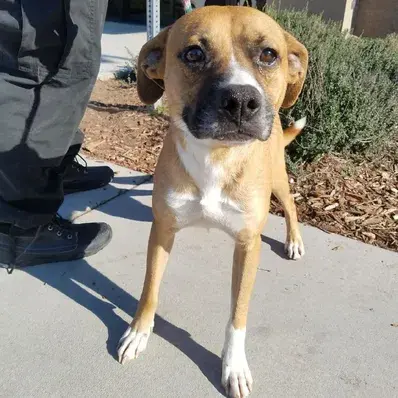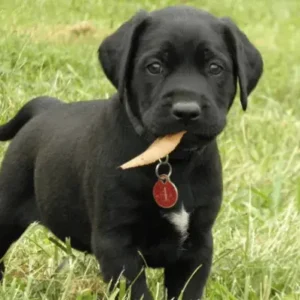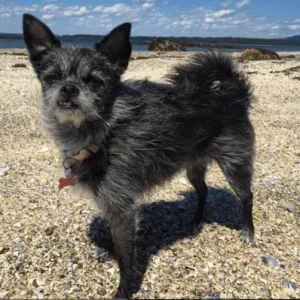Bullboxer Pit History/Origin
The Bullboxer Pit’s parent breeds have a fascinating history. Boxer originated in Germany in the 1800s and were used to transport supplies and deliver messages to troops during the World Wars. The American Pit Bull Terrier, on the other hand, was initially bred for blood sports, including bear and bull baiting.
The origins of the Bullboxer Pit dog breed can be traced back to the now-extinct German Bullenbeisser. Breeders still create this mixed breed by crossing Boxers with American Pit Bull Terriers.
Bullboxer Pit Personality
Bullboxer Pits are often used as farm or guard dogs, thanks to their loyal nature and impressive strength. They are deeply devoted to their families and can become especially protective of children in the household. While their loyalty is unquestionable, an exceptionally responsible owner must bring out the best in this breed. Early and consistent socialization is essential for developing a well-rounded and confident dog.
Thanks to their parent breeds, Bullboxer Pits are highly active dogs. They thrive on regular exercise to maintain their muscular physique and upbeat energy. Owners should commit to about two hours of exercise daily, including brisk walks, jogging, agility training, or swimming, to keep them happy and healthy.
- Potential Challenges
Bullboxer Pits face certain challenges, particularly regarding living arrangements and exercise needs. Apartment living may not suit them well, as many buildings restrict this breed, and their high energy levels are better suited to homes with space to roam. However, with diligent effort to meet their exercise requirements, they can adapt to smaller living spaces.
Additionally, their strong and protective instincts require a dedicated owner who can commit to ongoing training and socialization. Without proper attention and outlets for their energy, they may develop behavioral issues.
Bullboxer Pit Physical Appearance
This is a strong, well-muscled dog with a broad, flat head and a wide muzzle that ranges from short to medium in length. Their eyes are brown, small to medium in size, and can be either round or slightly almond-shaped. The ears are typically set high on the head and tend to fold forward or to the sides.
- Size
The Bullboxer Pit is typically considered a medium-sized dog, but they are often stockier and sturdier compared to many other dogs of similar size. They generally weigh between 50 to 80 pounds and stand 16 to 20 inches tall.
- Coat color
The Bullboxer Pit has a single-layer glossy coat that lies flat against the body, giving it a sleek and shiny appearance. Their coat can come in almost every color, except merle, and is often accented with black or white markings that create a striking contrast against their base color.
These markings can vary in shape and placement, adding to the unique beauty of each dog. Whether solid or multi-colored, their coat is typically low-maintenance, requiring minimal grooming to keep it looking healthy and shiny.
Bullboxer Pit Gender Differences
Gender differences in Bullboxer Pits are fairly typical of most dog breeds, though they can vary based on individual temperament and genetics.
Male Bullboxer Pits tend to be larger and more muscular, often weighing more and having a more solid build compared to females. They can also be more territorial or assertive, especially if not properly trained and socialized. Males may display dominant behaviors, which require consistent leadership from their owners.
Female Bullboxer Pits, while still strong and muscular, are usually a bit smaller and more slender than their male counterparts. They may be less aggressive or territorial and often have a more gentle demeanor. However, like males, females still need proper training, socialization, and exercise to thrive.
Both genders are known for their loyalty, affection, and protective instincts, but the key to their development lies in early training and consistent care.
Bullboxer Pit Feed/Nutrition
An ideal Bullboxer Pit diet should be tailored for a medium-sized breed with medium-to-high energy needs.
If a Bullboxer Pit isn’t properly trained or if their diet isn’t strictly monitored, they may develop a tendency to overeat. It’s important to stick to a regular feeding schedule and keep treats to a minimum to maintain a healthy weight.
As with all dogs, the Bullboxer Pit’s dietary requirements will change throughout their life—from puppyhood to adulthood, and into their senior years. It’s always best to consult your veterinarian for personalized recommendations.
Dogs can vary significantly in weight, energy levels, and overall health. These factors influence their specific dietary needs. Adding dog-safe fruits like mangoes in moderation can provide essential vitamins and natural sweetness to their diet.
Bullboxer Pit Health
As an athletic breed, Bullboxer Pits are generally healthy, but like all dogs, they can be prone to certain health issues. Regular care and routine veterinary visits are essential to ensure their well-being.
- Obesity: Obesity occurs when dogs consume more calories than they burn, leading to excess weight that can strain their joints, heart, and other organs. To prevent obesity, it’s important to monitor their diet carefully, adhere to a regular feeding schedule, and avoid excessive treats. Providing ample exercise will also help maintain a healthy weight.
- Cardiomyopathy: Cardiomyopathy is a heart condition where the heart muscles weaken, affecting the dog’s ability to pump blood efficiently. To prevent or manage this condition, regular veterinary checkups are crucial, especially for early detection, and feeding a heart-healthy diet along with ensuring adequate exercise can help reduce the risk.
- Hip Dysplasia: Hip dysplasia is a genetic condition where the hip joint doesn’t develop properly, causing pain and arthritis. Preventative measures include maintaining a healthy weight to reduce strain on the joints and providing joint supplements as recommended by your vet. Regular low-impact exercise like swimming is beneficial for maintaining joint health.
- Demodectic Mange: Demodectic mange is a skin condition caused by an overgrowth of mites that can lead to hair loss and skin irritation. Proper skin care, regular bathing, and a strong immune system are essential for prevention. If detected early, the condition can be managed with topical treatments or medication prescribed by your vet.
Bullboxer Pit Care and Grooming
As with all dog breeds, regular veterinary checkups are essential for Bullboxer Pits to detect any potential health issues early. Your vet can help create a personalized care plan to keep your dog in optimal health.
Along with a balanced diet, ensure they get a rigorous exercise routine, aiming for at least a couple of hours daily. Brisk walks, frisbee, swimming, and supervised agility training will help keep them active and healthy.
The Bullboxer Pit’s paw pads need special attention to prevent cracking and dryness. Your vet can recommend a suitable paw moisturizer to keep them in good condition. Though the Bullboxer Pit has a short, easy-to-care-for coat, they do shed year-round.
Brushing a few times a week can help manage shedding, and bathing once a month should be enough. If your Bullboxer Pit has inherited facial wrinkles from the Boxer parent, make sure to wipe their face weekly to prevent buildup.
Bullboxer Pits thrive in moderate climates, so it’s best to avoid extreme temperatures. For very cold weather, a stylish doggy jacket can keep them warm and comfortable. Leash training your dog is also essential to ensure they walk safely and confidently, as Bullboxer Pits are strong and energetic.
Bullboxer Pit Price
The average cost of a Bullboxer Pit typically ranges from $800 to $1,200. Prices can vary depending on factors such as breeder reputation, location, and the dog’s pedigree. It’s essential to choose a reputable breeder who follows ethical breeding practices to ensure a healthy, well-socialized puppy.
Bullboxer Pit Rescue Groups
If you’re considering adding a Bullboxer Pit to your family, don’t forget to check with local rescue groups. Many Bullboxer Pits in need of loving homes are available for adoption, offering a chance to provide a second chance to a deserving dog. Adopting from a rescue is a wonderful way to find a loyal companion while supporting ethical practices.
Interesting Facts
- Bullboxer Pits are not big barkers but use growls, whines, and howls to communicate, especially when seeking attention.
- Despite their muscular build, Bullboxer Pits enjoy swimming, providing a low-impact way to burn energy.
Best For
The Bullboxer Pit is best suited for active individuals or families who enjoy outdoor activities and can provide ample exercise. This breed thrives in a home where they receive plenty of attention, mental stimulation, and consistent training. With their loyal and protective nature, they make excellent companions for those who are experienced with dogs and committed to their care.
Top Names
| Male Bullboxer Pit Names | Female Bullboxer Pit Names |
| Max | Bella |
| Zeus | Luna |
| Diesel | Daisy |
| Titan | Ruby |
| Duke | Rosie |









 Boxer – Source:
Boxer – Source:  American Pit Bull Terrier- Source:
American Pit Bull Terrier- Source: 

 Brindle Bullboxer Pit- Source:
Brindle Bullboxer Pit- Source:  Tan Bullboxer Pit- Source:
Tan Bullboxer Pit- Source:  Brown Bullboxer Pit- Source:
Brown Bullboxer Pit- Source: 







